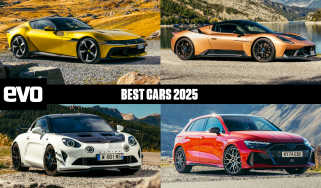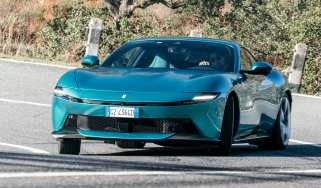Best McLarens ever - we test them all from F1 to P1 GTR - Interview - Mike Flewitt, McLaren Automotive CEO
McLaren Automotive’s CEO discusses the company’s future, and explains where hybrids, full EVs and autonomous vehicles fit in
How many McLarens will utilise hybrid powertrains in the near future?
We know where we’re going with our powertrains year on year for the next seven, eight, nine years. We know when we’re bringing hybrid in and we can see ourselves going to a mix of hybrid and eventually full hybrid across the range. So, I expect something like 50 per cent of the range to be hybrid by 2022.
Are full-electric powertrains, at some point, an inevitability?
I do think it’s a journey – but we believe the world will go to full EV. However, it’s still got to provide a compelling driving experience. What will then continue to evolve is the power source, whether it’s batteries or hydrogen or whatever.
What was the view from the McLaren board on the ‘inevitability’ of EV?
We got into the usual debate: ‘Well you know what, can you imagine an EV being as compelling as a P1 or an LT?’ and frankly, the answer was, ‘No, I can’t.’ We said, ‘Well we’ve got to resolve this. There’s got to be a way to resolve this.’
We did it with P1. P1 changed everybody’s mindset in here, from the concept of a hybrid being a vehicle that was done for environmental reasons, efficiency reasons, fuel economy reasons, to making the character of the powertrain quite a compelling part of the vehicle.
I can fully understand someone having an F1 and a P1 and loving them both despite their differences – and to have a debate about which is better is almost irrelevant. They’re different but they’re both absolutely glorious. We’ve got to make an EV that’s absolutely glorious. I’m convinced we’ll be able to do it but we’ve got to work on what are the emotional touch points of it.
So the most significant task ahead is not generating the speed, it’s engineering the ‘Thrill of Driving’ into an EV?
Making it fast enough isn’t a challenge. Tesla are building vehicles weighing two, two-and-a-half tons that have got phenomenal acceleration, and building an EV is actually probably more straightforward than a conventional powertrain. Packaging an electric vehicle is more flexible and getting great ride and handling isn’t such a challenge in its own right. No, pure performance isn’t such an issue, it’s the feedback you get.

Have you learnt anything from developing the current range that will help solve this problem?
A 675LT is immediately exciting, almost from just pulling away. Chris [Goodwin, McLaren’s chief test driver] said it very early on when we were developing that car: at 30 miles an hour that car feels exciting. How? We changed the way the powertrain was damped so there’s powertrain vibration coming through to the customer, we changed a little bit on steering feel, we reduced the NVH, we changed the way the noise was allowed in. It’s not generated noise but we do choose what we let in and what we don’t let in, so exhaust noise and intake noise. All of that is much more than the fact that it’s got 25bhp more than the 650S, which frankly you have to be doing something pretty special to notice.
So how does that translate to an EV?
Noise is clearly a question. You’ve got lots of road noise. Road noise becomes probably the dominating factor because if the vehicle is well designed, wind noise and such shouldn’t be an issue. You’ve got very little powertrain noise of any description so you’ve got road noise coming through. What do you do about vibration? Well you’ve got nothing from the powertrain but there’s nothing to stop you having vibration and feedback from the road.
So with noise diminished, your other senses need to feel amplified?
Yes. The thought process around this is all going to be around the feedback that you get from the road. What can you do about sensation of speed? That I think is quite a challenge because in a sense most of what you do dumbs that down. It’s like if you drive an old car. If I drive my old Elan, I feel like I’m going twice as fast as I’m going in a McLaren. As we make the car more and more and more refined, you can isolate the driver from the experience and that’s actually not what we want to do.
How will your next hybrid use electrification to augment performance?
If you never plug it in, you will still have sufficient battery to drive and pull away, albeit how far you go will diminish significantly. You’ll get the torque fill and you’ll get the low-end boost. The battery will never run below I think it’s around 20-something, 22 or 23 per cent, so that you’ve always got that characteristic and the battery is charging through the use all the time.
There will be a battery-charge mode again, as there is with P1, so that if it’s never plugged in you can run a cycle that is putting charge back into the battery. If you want everything full on then the most efficient way to use it is to plug it in.
When we do a hybrid vehicle, we will probably only do a hybrid vehicle. You won’t be able to come along and say, ‘Can I have a 570S or a 570S hybrid?’ We will develop the concept of that vehicle as a hybrid and therefore the offering has to be one that satisfies the whole customer base with that powertrain solution.
If you plug it in or if you don’t plug it in, it will work. For track use we’ve actually looked at how long people go out on tracks and typically 20 or 30 minutes at a time is a good use, then you come back in and put it on a rapid charge. You’ll get it back up very quickly to about 80 per cent battery and then go out, use it and enjoy it.
But you’ve plugged it in to get 80 per cent.
We need batteries to get better, we need charging to get better, but you’ll get the full driving experience of the car so it will still be a very useable, very practical proposition, even if you’ve never plugged it in.
When and how do you see autonomous driving as part of the motoring landscape?
First of all, I see it as an inevitability. On a very personal level, I don’t have any problem driving but that’s kind of irrelevant because it is where I see the world going and it does drive safety and it will drive efficiency as well. A world where there’s autonomous EVs – certainly inside cities – is coming. I don’t know how quickly. I see the introduction being incredibly complex.
How do you blend the human- and the machine-operated vehicle? How do they share the same road?
Unless you had a city state with a dictator who could ban all vehicles bar autonomous electric vehicles then integration with all the vehicles that are out there today needs to occur. I think that is a particularly complex proposition. The issues around social acceptability, around legislation and around accountability and responsibility if something happens, they’re going to be enormously difficult to resolve. Nonetheless, I can see it coming. I think it will come into things like taxis and public service vehicles and so on early on.
What does this mean for McLaren?
I can see us almost going back a cycle. Either we will have an autonomous capability in the car that enables you to use it like that where it’s mandated to do so, and where it’s not mandated to do so you can take over and drive it. Or our cars will become purely leisure, entertainment propositions, and day-to-day driving will become just transport, which an autonomous vehicle will take care of. They’ll separate, which when you get back into the personal bit, that’s a crying shame. The one thing I can’t bear is the thought of having a boring car. I love driving. I like driving, whether I’m driving to work or whatever else. The thought of trading that to have something that just ferries me to work, I mean it would take something away from my life.


